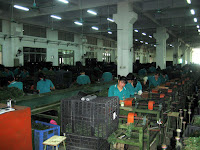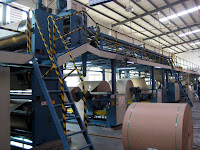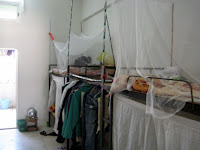Today I went to Heyuan, China to visit a factory with the owner. Heyuan is about 3 1/2hrs from Hong Kong in the Pearl River Delta. The factory is about 90% vertically integrated so they purchase raw materials and manufacture nearly everything they need for the process. They make christmas trees, ornaments, lights, and yard signs during the summer and inflatable pools and toys during the winter. Most of the products go to the big buyers in the US (Walmart, K-mart, Target, Home Depot) and the factory supplies a majority of the x-mas tree market. Walmart alone buys 1.2 million trees. When operating at capacity the factory employs 20,000 people and runs 24 hrs/day.


There are several ways to make the branches of the x-mas trees. They purchase the metal in sheets and then curl it and cut it to make the "wood" part of the branch. The most expensive branches are cast in a mold with liquid plastic. The less expensive branches are made by cutting sheets of plastic into "needles" and twisting them on to the branch. All of this is done by a combination of people and machines.
The factory produces copper wires and coats them in green plastic to make strands of Christmas lights. The lights are outsourced because the technology to produce them is so basic and well-established that it makes more sense to buy them than to produce them in house. When the lights come back they are tested and then hand strung onto all of the branches.
The factory also produces the metal inserts that hold the branches to the center "trunk." The process starts with sheet metal and a machine (operated by a worker) cuts the metal to shape. Another machine bends the metal so that it can hold branches. This part can be dangerous because the worker needs to reach into the machine to put each metal piece in. To mitigate this the factory is working on a new design that is more efficient and eliminates the need to reach into the machine. This video shows a worker inserting metal cut-outs into a machine.
The factory began producing ornaments this year. The melted plastic is inserted into a mold and then blown into shape. Then a worker files down the seam and arranges them on an automated rack. The racks move through liquid primer, paints, and a drying section.
Some ornaments get hand glued designs and then coated in red and gold glitter. This process is still being adjusted.

The factory also produces cardboard and plastic handles for the boxes, shipping labels, plastic wrap, and bubble wrap. It is amazing how large the facility is and how much they produce!


Many of the workers live in dorms at the factory. The average age of a worker is 26 and many come from rural provinces to work for 3-4 yrs, save money, and then return home. The opportunities are greater in manufacturing areas and they are able to return home and have a more comfortable life. The owner told me that women workers are preferred because they are very productive, have fewer fights, and are very motivated. Workers are allowed to work 8 hr shifts with up to 2 hours of overtime. Many workers do the overtime and are willing (but unable) to work more hours. The dorms are adjacent to the factory buildings and each room houses 6-8 workers. The rooms are very basic and have beds, nets, and clothing racks. There is a canteen and a medical clinic on the property.
The facility is frequently inspected for quality control and labor regulation. The factory began making ornaments this year at the request of Walmart because Walmart found problems with child labor and quality control in their previous suppliers.
The factory tour was fascinating and definitely worth all of the time in the car!
 Swimming with barracuda
Swimming with barracuda